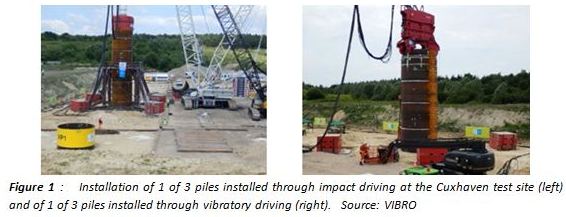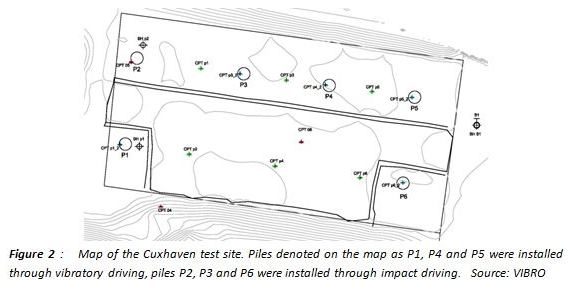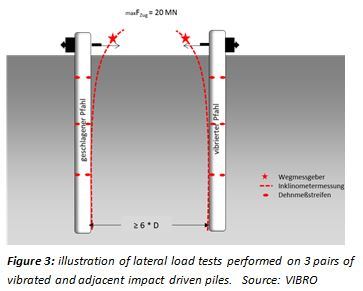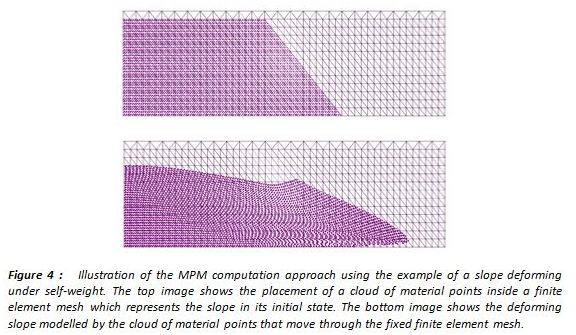
◀ Back to projects overview P201406_002_DEL
Numerical Simulation of the Installation of Vibratory and Impact Driven Piles
Public summary
Offshore vibratory driven pile installation offers several advantages over widely used impact driven pile installation. It emits less peak noise and could therefore be applied without expensive noise mitigation measures for protection of marine life throughout the entire year. It takes less time so that cycle times for foundation installation are lower, rendering shorter installation charter periods and allowing use of shorter weather windows. Vibratory pile driving involves lower fatigue loads which could be used to optimize the structural design either through a reduction of steel mass or an increase in design life. All of these advantages entail cost and time reduction in the construction of wind parks.
However, vibratory driving of monopiles in the construction of wind parks is not straightforward. For one, monopiles have to accurately maintain the vertical alignment of wind turbines over several decades under continuous lateral cyclic loading. In contrast to established pile installation techniques such as impact driving, it is unknown whether a sufficiently high lateral system stiffness can be achieved with vibratory pile driving for the different soil conditions found in the North Sea and how the build-up of lateral system stiffness is influenced by the vibration process, i.e. the penetration rate, vibrator frequency and eccentricity. Certifying bodies therefore currently recommend impact driving at least over the last part of the installation depth which reduces the cost and time benefit of vibratory pile driving.
A complementary use of different driving techniques would seem a reasonable approach. Finding a cost effective solution here is only possible if the installation effects of vibratory and impact driving techniques are well understood.
Greater understanding of the installation technique also can help to dimension pile driving equipment less conservatively, leading to cost reductions. Both vibratory and impact driving carry the risk of pile refusal due to the equipment being too small to deal with the encountered soil density. To counteract this, used equipment is generally sized very conservatively.
An industry-funded field experiment was performed in 2014 in Germany in the frame of the VIBRO project to gain more insight into the relation between the used pile installation technique and the obtained lateral system stiffness. Full-scale monopiles were installed through vibratory and impact driving in a sandpit near Cuxhaven. Subsequently, lateral load tests were performed on the piles to assess their lateral system stiffness. Cone Penetration Tests (CPT) were performed at the site before and after pile installation to estimate from measurements soil densification in the vicinity of the piles.
Figures 1 to 3 illustrate the performed field experiment.
Objectives
The FLOW project NS-VIP follows up on this project with the aims of
a) developing a numerical model that can simulate the installation process of vibratory and impact driven piles and which captures the pile-soil interaction under lateral loading;
b) validating the numerical model using the measurement data of the VIBRO project and of;
c) developing a database which relates lateral system stiffness to pile diameter, installation method and initial soil density for (offshore) sites in the North Sea.
The numerical analyses of pile installation such as those of this project allow gaining a deeper understanding of processes taking place in the subsoil during pile penetration, complementary to experiments such as the VIBRO project. They thereby open the path to cost and risk reduction in offshore pile installation such as those mentioned further below.
Approach
Numerical simulations of impact and vibratory driving of offshore monopiles are very demanding. The highly nonlinear deformation behaviour of sandy soil has to be taken into account, such as the dependence of sand stiffness and dilatancy on stress level and vibration amplitude. Also, nonlinearity introduced through large soil deformations in the vicinity of the pile wall requires consideration. Advanced modelling techniques are required with regard to the modelling of liquefaction of the water-saturated soil in the vicinity of vibrated piles. Under dynamic loading at high frequencies soil stresses decrease down to nearly zero leading to a corresponding decrease of frictional soil strength.
Much progress has been made throughout recent years in numerical analyses of geotechnical problems involving large deformations of water-saturated soil by means of the Material Point Method (MPM). This new numerical method has been developed specifically for the simulation of large deformation processes. It is closely related to the widely-used Finite Element Method (FEM). As with the FEM, equilibrium equations are solved on a background finite element mesh. Large deformations of soil are modelled with the MPM by a cloud of material points that moves through the fixed mesh, whereas with the FEM this can be done by updating the mesh according to soil deformations. The MPM avoids numerical problems related to severe mesh distortions which limit applicability of the FEM with large deformation problems. Figure 4 illustrates the simulation approach of the MPM. The MPM features a straightforward solution for modelling soil-structure and water-structure interaction. It has been extended recently for coupled 2-phase analyses. The Hypoplastic soil model, a highly nonlinear density dependent model for sand, is available for use with the MPM.
Deltares is together with UPC Barcelona, University of Cambridge, TU Hamburg-Harburg, University of Padova and TU Delft partner in a consortium which is developing a multi-phase dynamic MPM for applications in geotechnical engineering. This MPM has been considered in this research project.
Results
In the frame of this project a numerical model has been developed based on the MPM for impact and vibratory driven installation of hollow piles. The study rendered a realistic solution for the simulation of monopile installation with the MPM and of subsequent lateral load tests with the FEM with regard to computation time and quality of results taking into consideration large deformations, dependence of soil stiffness on density through advanced soil modelling and frictional pile-soil contact.
MPM simulations of Cone Penetration Testing were performed to calibrate material parameter estimates of the chosen soil model through comparison of numerical results with Cuxhaven field measurements of CPT. A reasonable match has been found.
Preliminary small- and large-scale check analyses were performed to assess the proper functioning of the MPM ahead of the final pile installation analyses of the Cuxhaven site. Considerable improvements and extensions of the MPM were made in preparation of the final analyses.
Subsequently, the numerical tool has been utilised to simulate the installation process of the Cuxhaven piles. The computed pile installation effects were then used as initial conditions for FEM simulations of lateral load tests.
Not all goals could be achieved. Stepwise development, calibration and testing of the numerical model required most of the project time in 2015. Long computation times and numerical difficulties encountered with the prepared numerical analyses of the Cuxhaven piles and of a field case did not allow to complete the analyses during the remaining 4 months. Encountered problems were evaluated but could only partly be solved in the frame of this project. The performed analyses represent a first step towards validation of the numerical model. Further improvements of the MPM are necessary to obtain a robust solution for vibratory and impact driven analyses with reasonable computational effort. Obtained results demonstrate the feasibility of MPM simulations of impact and vibratory pile driving and that useful insight into pile driving can be obtained from such analyses. The development of a database based on analyses with a validated MPM-based numerical model which relates lateral system stiffness to pile diameter, installation method and initial soil density for (offshore) sites in the North Sea thus proved one step too far within this 1-year project. Improvements of the MPM and further numerical analyses are necessary to obtain such a database.
Contribution
Cost reduction estimates
On the basis of several cost calculations related to different base cases, it is estimated that cost reductions between 1 and 2% of total costs can be achieved if pile installation effects on the soil are better understood.
Risk reductions
The improvements of pile installation possible through numerical analyses lead to a lowered CAPEX and a lowered value of equipment used which, in turn, leads to lower premiums on the related insurances. This secondary effect is, however, difficult to quantify at this moment and hence omitted in the performed cost calculations.
Contact details
Mr. Lars Beuth
Project documents
![]() Annex 1 1210768 NSVIP Technical Report Part 1
Annex 1 1210768 NSVIP Technical Report Part 1
![]() Annex 3 Report NSVIP 20 April 2015
Annex 3 Report NSVIP 20 April 2015
![]() Annex 4 Report NSVIP 8 July 2015
Annex 4 Report NSVIP 8 July 2015
![]() Annex 5 Report NSVIP NSVIP 21 Oct 2015
Annex 5 Report NSVIP NSVIP 21 Oct 2015





 Share this page
Share this page
